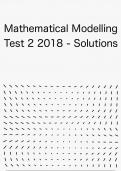Mathematical Modelling
Test 2 2018 - Solutions
, University of the Witwatersrand
APPM1006/A: Mathematical Modelling - Test 2
Instructions
• There are 50 marks available. 50 marks = 100%.
• Answer all the questions and show all necessary working. It is in the interest of the
candidate to write legibly and argue carefully.
• Unless otherwise specified, accuracy to at least 6 decimal digits should be maintained
in all computations.
• Unless otherwise specified, give your FINAL answer to 4 decimal digits.
• For the Multiple Choice Questions, there is only ONE correct answer.
• Please fill in your answers for Question 1 on the MCQ card provided.
Time: 60 minutes
Date: 23 October 2018
xxiii
Marks: 50
Question 1 - Multiple Choice Questions (10 Marks)
[1.1] What is the next term of the sequence 1, 5, 19, 65, ... given that the sequence can be
generated by a second order homogeneous linear difference equation with constant coeffi-
cients? [2]
A. 665
B. 109
C. 211
D. 111
ERROR
1
IN QUEsew
, [1.2] Suppose that compound interest of 12% is charged on the outstanding debt of a loan,
and suppose that the conversion period is monthly and repayments are also made monthly.
Between repayments the debt increases because of the interest charged on the outstanding
debt after the last payment. If D k denotes the debt after k payments and R is the payment
made at the end of each conversion period, which of the following best describe the dynam-
ics of the outstanding debt. [2]
A. D k+1 = D k + 0.012D k ° R Exam
B. D k+1 = D k + 0.12D k ° R
C. D k+1 = D k + 0.1D k ° R
÷
D. D k+1 = D k + 0.01D k ° R
xk
[1.3] Solve x k+1 = given x 0 = 2. The value of x 6 rounded to 4 decimal places is [2]
1 + xk
A. 0.2875
B. 0.2308
C. 0.2508
D. 0.2222
Erker IN ANEston
[1.4] Which of the following has been incorrectly matched? [2]
Mathematica Description
A
B
==
:=
Assign value
Delayed evaluation or assignment
Exam
C =. Clear value
D None of the above
[1.5] Which of these picks out all elements from the list
{ f [1] , g [2], f [5], g [3]} matching g [ _ ]]? [2]
A. C ases[{ f [1], g [2], f [5], g [3]}, _ ]
B. C ases[{ f [1], g [2], f [5], g [3]}, g [ _ ] ] Exam
C. C ases[{ f [1], g [2], f [5], g [3]}, _ f ]
D. None of the above
2




